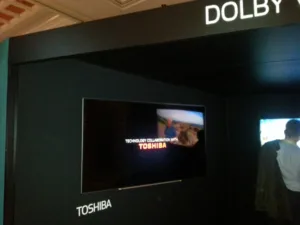We had an opportunity to meet with Dolby while at CES 2015 and learn more about the company’s efforts to bring High Dynamic Range (HDR) to the mass market. This involves getting the entire ecosystem from content creation to home TVs to adopt the technology.
Dolby has been a clear leader in HDR, but it may not end up owning the space. Implementing Dolby Vision, its version of HDR, will require licensing the technology and will cost players money. Alternatives are now being proposed, particularly by Philips, that will allow more diversity in the HDR implementation space. Movie Labs, the voice of Hollywood on many technical matters, seems to be pushing for an HDR standard that can accommodate various implementations of HDR. The newly form UHD Consortium will be addressing the HDR issue as well as other related issues. Nothing is set yet and discussions tend to be confidential on many matters, so there is only a limited amount that can be reported at this time.
During our meeting with Dolby, the company provided some updates on its agreement with Warner Bros. The studio is developing HDR versions of several titles including the Lego Movie, The Edge of Tomorrow, Into the Storm and other library content. Content creators already have cinema grade cameras that can capture in HDR with 12-14 stops of dynamic range, but they need to learn how to better use this dynamic range. For example, it is likely that new lighting or exposure techniques may have to be developed. But, Dolby is working hard to get HDR monitors onto the sets to allow instant feedback in HDR so that cinematographers can make the adjustments they need on-set or in the post-production houses. The impact on special effects is on-going as well. Just as 3D was a new creative tool to learn, so will HDR.
The theatrical screening of HDR content is coming too. We told you about an HDR projector that we saw at Christie. This is apparently a Dolby design that Christie is developing and manufacturing for Dolby and will be the platform for the projection of HDR movies in the newly announced Dolby Cinema initiative. These will be theaters that incorporate HDR, 3D, Dolby Atmos audio and more and will compete with IMAX and other high-end theatrical venues. The first theater has now opened in Eindhoven, although no HDR feature films are available yet. Currently, the projector uses a laser light source, but will soon upgrade to a Dolby Vision laser source.
Meanwhile, Christie and Barco are undoubtedly working on their own versions of HDR projection to offer to mainstream venues.
Dolby has also been active in developing tools to plug into the production workflow to enable HDR filmmaking. Plug-in tool sets are now available for Filmlight, Davinci Resolve, SGO and others. Dolby says it is working with the top five toolset makers to add the HDR capability to the grading and production process. Dolby envisions content creators mastering first to the HDR standard, then creating derivative versions semi-automatically. That means a “trim pass” will be needed by the colorist to tweak the grading to fit different color spaces and lower luminance levels. But the timing of theatrical releases may require that a DCI grade is done first with the HDR and other grades done later.
For delivery, Dolby says it is working with Netflix and now Vudu to delivery over the top HDR content to consumers. The firm is also working with the Blu-ray Disc Association to be sure HDR is part of this spec too (it is) Ultra HD Blu-ray Plans Firming Up.

